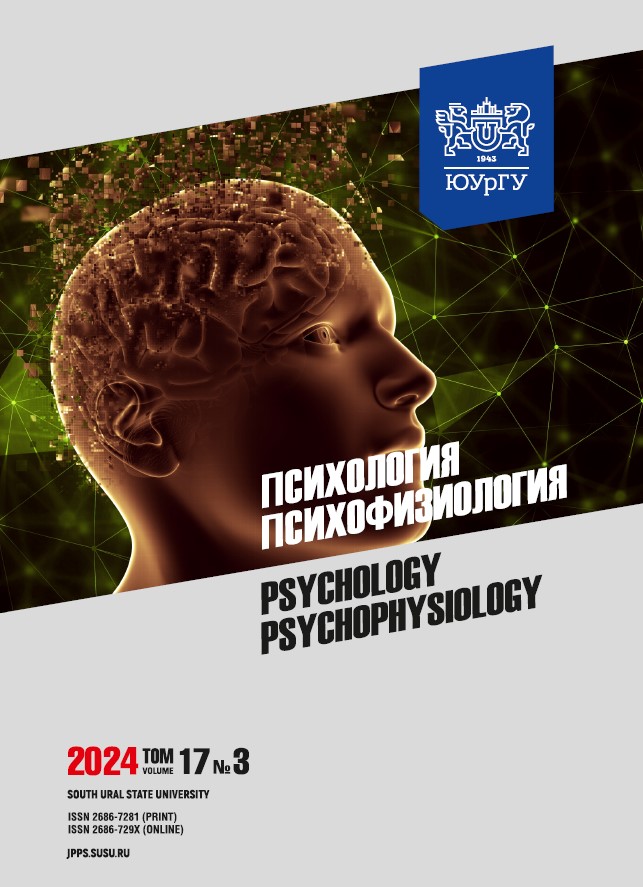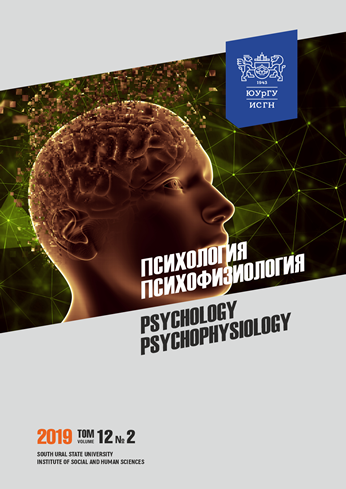Correlation between baseline individual and typological characteristics of resting heart rate variability and sensorimotor performance in different social contexts
Abstract
Introduction. Investigating the psychophysiological mechanisms of social interactions holds crucial implications for enhancing educational outcomes, boosting labor productivity, and preserving the psychosomatic well-being of populations. This study aims to uncover the relationships between the baseline individual and typological characteristics of heart rate variability (HRV) and sensorimotor performance in individual, competitive, and cooperative social contexts. Materials and methods. Our study involved 130 male participants aged 18–28 years. The “Columns” module of the BOS-Kinesis software and hardware system (Neurotech LLC, Taganrog, Russian Federation) was used for sensorimotor training. The assessment comprised four stages: 1) baseline ECG recordings and HRV measurements to determine the effect of the autonomic and central nervous systems on cardiac activity; 2) individual training sessions; 3) competitive pair activities; 4) two rounds of cooperative training activities with and without feedback. Results. Based on the most relevant baseline HRV indicators, all subjects were divided into three clusters characterized by different cardiac activity regulations: normotonic and predominantly influenced by either sympathetic or parasympathetic nervous systems. Notably, those exhibiting predominant sympathetic influences showed decreased cooperative performance, whereas those with parasympathetic dominance performed better in cooperative contexts. Baseline HRV measurements suggested that better cooperative performance was associated with enhanced suprasegmental and parasympathetic cardiac regulation, while competitive performance was associated with sympathetic nervous activity. Conclusion. Sensorimotor performance in competitive and cooperative contexts depends on the baseline autonomic regulation of cardiac activity in subjects
Downloads
References
2. Hatzenbuehler M.L., McLaughlin K.A., Weissman D.G. et al. A research agenda for under-standing how social inequality is linked to brain structure and function. Nature Human Behaviour. 2024;8(1):20–31. DOI: 10.1038/s41562-023-01774-8.
3. Kanbay M., Tanriover C., Copur S. et al. Social isolation and loneliness: Undervalued risk factors for disease states and mortality. European Journal of Clinical Investigation. 2023;53(10):e14032. DOI: 10.1111/eci.14032.
4. Teshale A.B., Htun H.L., Hu J. et al. The relationship between social isolation, social support, and loneliness with cardiovascular disease and shared risk factors: A narrative review. Archives of Gerontology and Geriatrics. 2023;111:105008. DOI: 10.1016/j.archger.2023.105008.
5. Gottman J.M. Detecting cyclicity in social-interaction. Psychological Bulletin. 1979;106(52):338–348. DOI: 10.1037/0033-2909.86.2.338
6. Petrocchi N., Cheli S. The social brain and heart rate variability: Implications for psychotherapy. Psychology and Psychotherapy: Theory, Research and Practice. 2019;92(2):208–223. DOI: 10.1111/papt.12224.
7. Murtazina E.P., Matyulko I.S., Zhuravlev B.V., Golubeva N.K. Somatoautonomic components of social interactions (review). Zhurnal mediko-biologicheskikh issledovanii = Journal of Medical and Biological Research. 2019;7(3):349–362. (in Russ.). DOI: 10.17238/issn2542-1298.2019.7.3.349.
8. Mauersberger H., Tune J.L, Kastendieck T. et al. Higher heart rate variability predicts better affective interaction quality in non-intimate social interactions. Psychophysiology. 2022;59(11):14084. DOI: 10.1111/psyp.14084.
9. Tiwari R., Kumar R., Malik S. et al. Analysis of Heart Rate Variability and Implication of Different Factors on Heart Rate Variability. Current Cardiology Reviews. 2021;17(5):e160721189770. DOI: 10.2174/1573403X16999201231203854.
10. Eppinger H., Hess L. Die Vagotonie. Berlin: Eine Klinische Studie. 1910:320.
11. Baevskiǐ R.M. Concept of physiological norm and criteria of health. Russian Journal of Physiology. 2003;89(4):473–487
12. Vein A.M., Voznesenskaya T.G., Vorobeva O.V. et al. Vegetativnye rasstroistva: klinika, diag-nostika, lechenie: rukovodstvo dlya vrachei [Vegetative disorders: clinic, diagnosis, treatment: guide for doctors]. Ed. V.L. Golubeva. Moscow. Med. inform. Agency. 2010:637.
13. Knyazeva E.S., Lyalyakin S.V., Mishchenko N.V., Trifonova T.A. An Evaluation Of The Functional State Of The Body Of Students Using Heart Rhythm Variability Parameters. Mezhdunarodnyi nauchno-issledovatelskii zhurnal = International Research Journal. 2023;1(127):8. DOI: 10.23670/IRJ.2023.127.8. (in Russ).
14. Klimenko A.V., Pertsov S.S. Physiological Support of Goal-Directed Activity in Human. Byulleten eksperimentalnoi biologii i meditsiny = Bulletin of Experimental Biology and Medicine. 2023;176(7):4–13. DOI: 10.47056/0365-9615-2023-176-7-4-13. (in Russ)
15. Arakaki X., Arechavala R.J., Choyуе E.H. et al. The connection between heart rate variability (HRV), neurological health, and cognition: A literature review. Frontiers in Neuroscience. 2023;1(17):1055445. DOI: 10.3389/fnins.2023.1055445.
16. Yadrishchenskaya T.V. Typological Features of Vegetative Regulation in the Aspect of System Relationship. Sovremennaya nauka: aktualnye problem teori i ipraktiki. Seriya: Poznanie = Modern Science: actual problems of theory and practice. Series: Cognition. 2022;1:64–68. DOI: 10.37882/2500-3682.2022.01.19. (in Russ).
17. Gorelik V.V., Filippova S.N., Nazarenko N.N. Improving the indicators of schoolchil-drens adaptation to physical activity using an individual approach, taking into account the types of vegetative regulation. Sportivnaya meditsina: nauka i praktika = Sports medicine: research and practice. 2022;12(4):29–39. DOI: 10.47529/2223-2524.2022.4.9. (in Russ).
18. Klimenko A.V., Pertsov S.S., Yakovenko I.Yu. A correlation analysis of performance of purposeful activity and parameters of heart rate variability in people with different individual-typological features. Byulleten eksperimentalnoi biologi i imeditsiny = Bulletin of Experimental Biology and Medicine. 2019;167(5):532–536. (in Russ.).
19. Chen Y.S., Lu W.A., Pagaduan J.C. et al. A Novel Smartphone App for the Measurement of Ultra-Short-Term and Short-Term Heart Rate Variability: Validity and Reliability Study. JMIR mHealth and uHealth. 2020;31(8(7):e18761. DOI: 10.2196/18761.
20. Ito-Masui A., Kawamoto E., Esumi R. et al. Sociometric wearable devices for studying human behavior in corporate and healthcare workplaces. BioTechniques. 2021;71:392–399. DOI: 10.2144/btn-2020-0160.
21. Pulcinelli M, Pinnelli M, Massaroni C. et al. Wearable Systems for Unveiling Collective Intelligence in Clinical Settings. Sensors. 2023;23(24):9777. DOI: 10.3390/s23249777.
22. Deits-Lebehn C., Smith T.W, Williams P.G. et al. Heart rate variability during social interaction: Effects of valence and emotion regulation. International Journal of Psychophysiology. 2023;190:20–29. DOI: 10.1016/j.ijpsycho.2023.06.004.
23. Geisler F.C., Kubiak T., Siewert K. et al. Cardiac vagal tone is associated with social engagement and self-regulation. Biological Psychology. 2013;93(2):279–286. DOI: 10.1016/j.biopsycho.2013.02.013.
24. Zhu J., Ji L., Liu C. Heart rate variability monitoring for emotion and disorders of emotion. Physiological Measurement. 2019;40(6):064004. DOI: 10.1088/1361-6579/ab1887.
25. Algumaei M., Hettiarachchi I., Veerabhadrappa R. et al. Physiological Synchrony Predict Task Performance and Negative Emotional State during a Three-Member Collaborative Task. Sensors. 2023;23(4):2268. DOI: 10.3390/s23042268.
26. Heart rate variability. Standards of measurement, physiological interpretation, and clinical use. Task Force of the European Society of Cardiology and the North American Society of Pacing and Electrophysiology. European Heart Journal. 1996;17(3):354–381.
27. Gorelik V.V. Adaptation of pupilsregulatory systems (types of vegetative regulation) students to physical activityat the lesson of physicalculture. Rossiiskii mediko-biologicheskii vestnik imeni akademika I.P. Pavlova = I.P. Pavlov Russian Medical Biological Herald. 2015;23(2):32–40. (in Russ.). DOI: 10.17816/PAVLOVJ2015232-40
28. Glukhova M.E., Lukyanov D.A., Ezhentsev V.S. The influence of the prestart state on the result of public performances by students. Problemy sovremennogo pedagogicheskogo obrazovaniya = Problems of modern pedagogical education.2022;76-1:90–93. (in Russ.).
29. Babushkin G.D. Psychological qualities that affect the athletes pre-start state and the effectiveness of competitive activity. Psikhologiya i pedagogika sportivnoi deyatelnosti = Psychol-ogy and Pedagogy of sports activity. 2023;1(64):19–23. (in Russ.).
30. Sahi R.S., Eisenberger N.I., Silvers J.A. Peer facilitation of emotion regulation in adolescence. Developmental Cognitive Neuroscience. 2023;62:101262. DOI: 10.1016/j.dcn.2023.101262.
31. Garcia-Marques T., Fernandes A.C. Meta-Analysis of Social Presence Effects on Stroop Task Performance. Psychological Reports. 2024;30:332941241227150. DOI: 10.1177/00332941241227150.
32. Saladino V., Algeri D., Auriemma V. The Psychological and Social Impact of Covid-19: New Perspectives of Well-Being. Frontiers in Psychology. 2020;11:577684. DOI: 10.3389/fpsyg.2020.577684.
33. Sutin A.R., Stephan Y., Luchetti M. et al. Differential personality change earlier and later in the coronavirus pandemic in a longitudinal sample of adults in the United States. PLOS One. 2022;17(9):e0274542. DOI: 10.1371/journal.pone.0274542.
34. Shmatova Yu.E. Mental health of population in the COVID-19 pandemic: trends, consequences, factors, and risk groups. Ekonomicheskie i sotsialnye peremeny: fakty, tendentsii, prognoz = Economic and Social Changes: Facts, Trends, Forecast. 2021;14(2):201–224. (in Russ.). DOI: 10.15838/esc.2021.2.74.13.
35. Fedorowski A., Fanciulli A., Raj S.R. et al. Cardiovascular autonomic dysfunction in post-COVID-19 syndrome: a major health-care burden. Nature Reviews Cardiology. 2024;2. DOI: 10.1038/s41569-023-00962-3.
36. Porges S.W. Polyvagal Theory: A biobehavioral journey to sociality. Comprehensive Psychoneuroendocrinology. 2021;7:100069. DOI: 10.1016/j.cpnec.2021.100069.
37. Magnon V., Vallet G.T., Benson A. et al. Does heart rate variability predict better executive functioning? A systematic review and meta-analysis. Cortex. 2022;155:218–236. DOI: 10.1016/j.cortex.2022.07.008.
38. Lischke A., Lemke D., Neubert J. et al. Inter-Individual Differences in Heart Rate Variability Are Associated with Inter-Individual Differences in Mind-Reading. Scientific Reports. 2017;7(1):1557.
39. Vanutelli M.E., Gatti L., Angioletti L. et al. May the Best Joint-Actions Win: Physiological Linkage During Competition. Applied Psychophysiology and Biofeedback. 2018;43(3):227–237. DOI: 10.1007/s10484-018-9402-8
References on translit
-Copyright (c) 2024 Psychology. Psychophysiology

This work is licensed under a Creative Commons Attribution-NonCommercial-NoDerivatives 4.0 International License.



